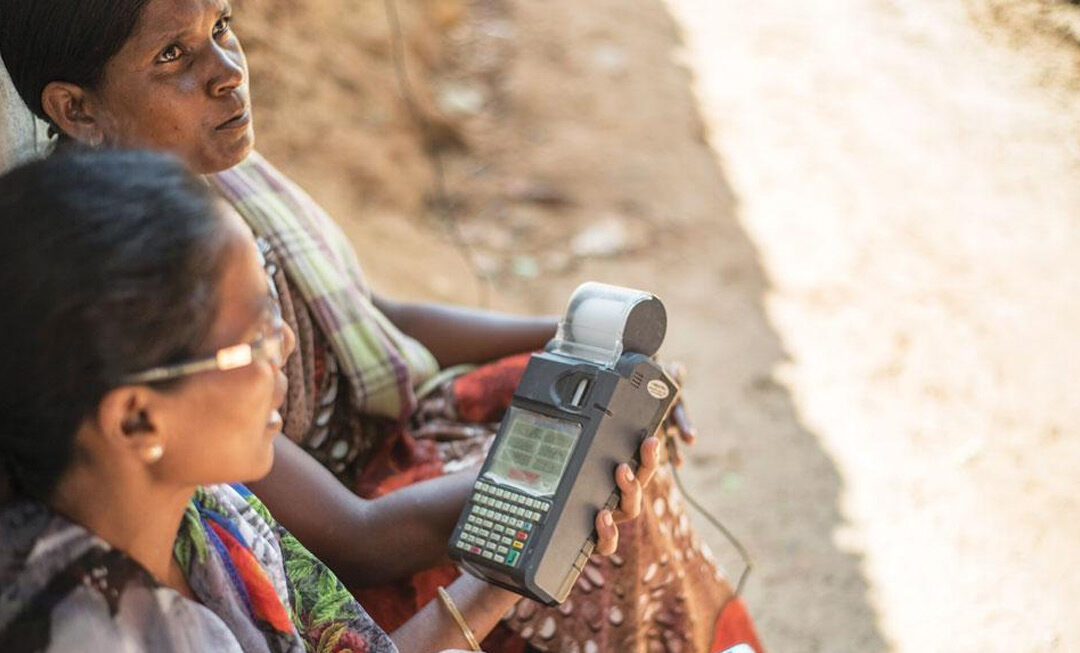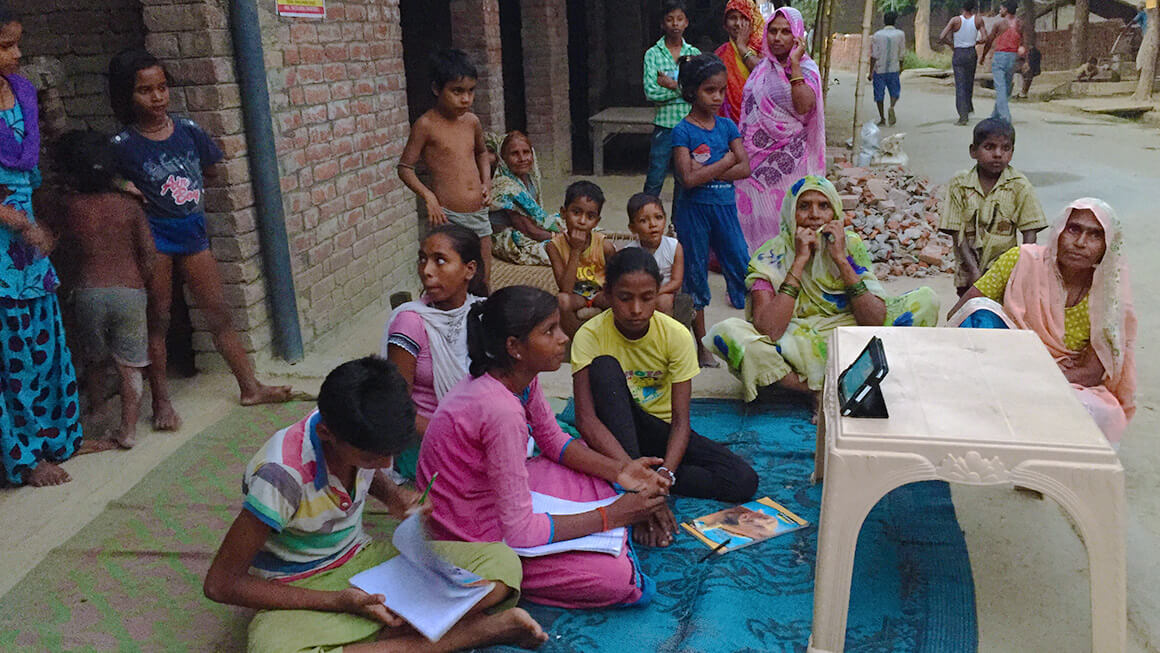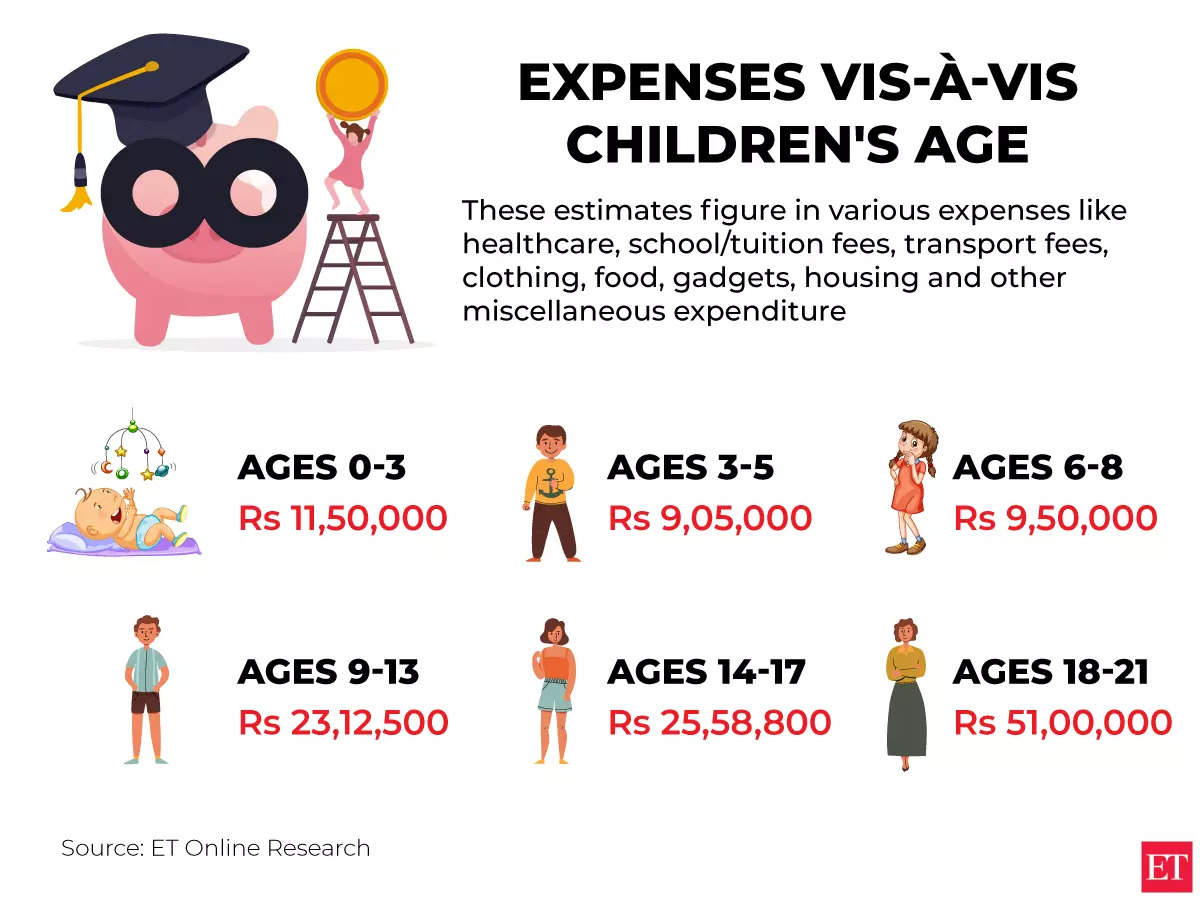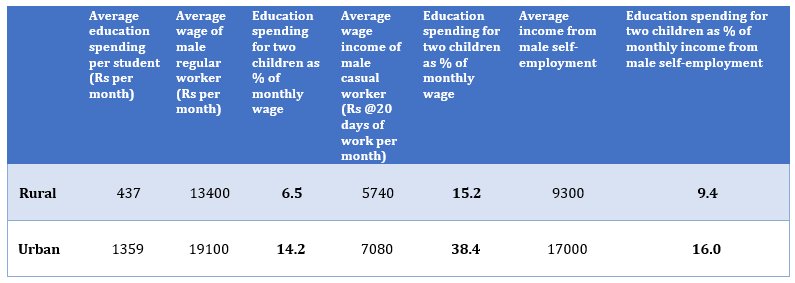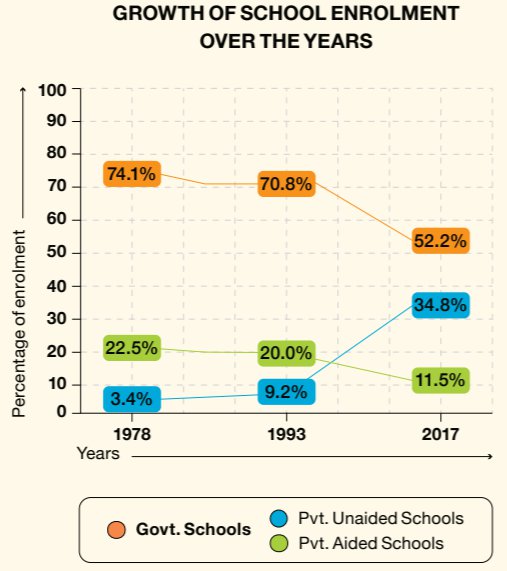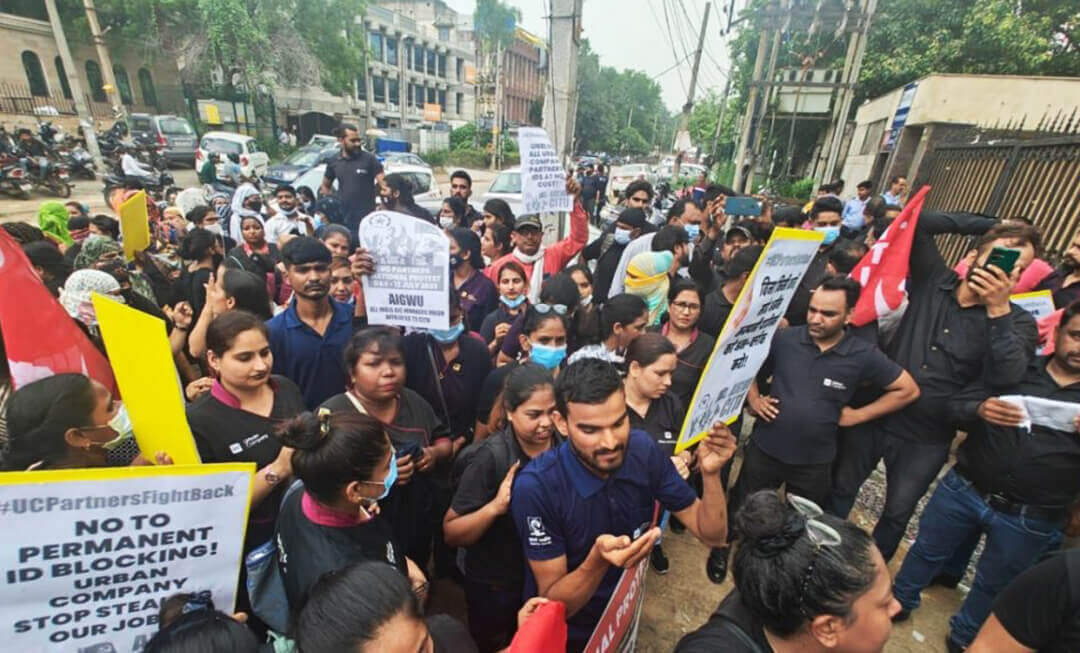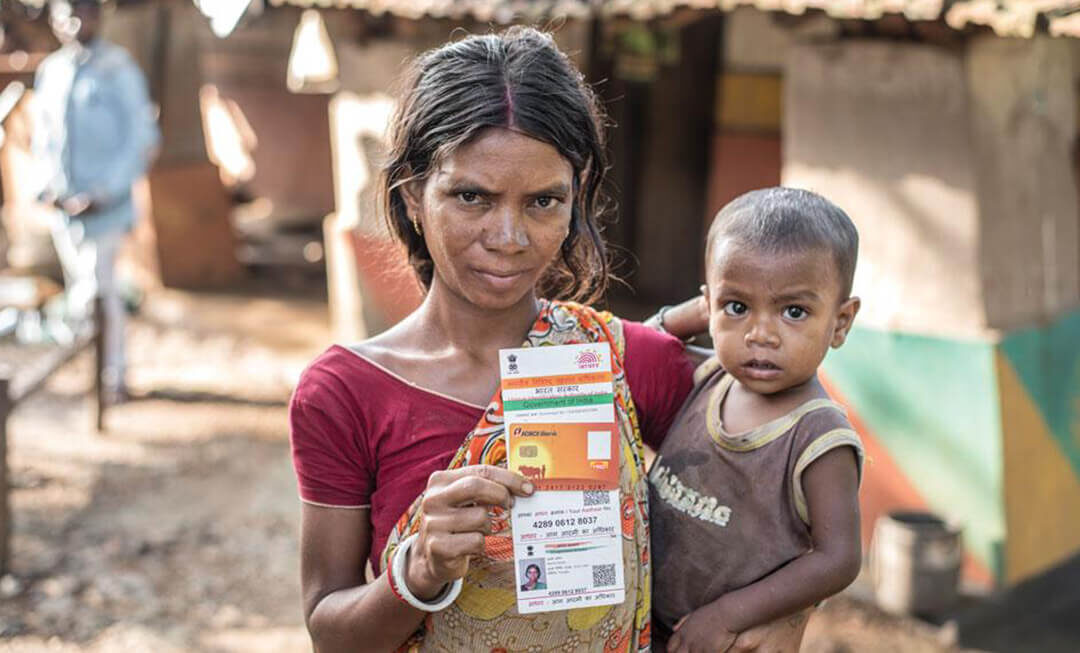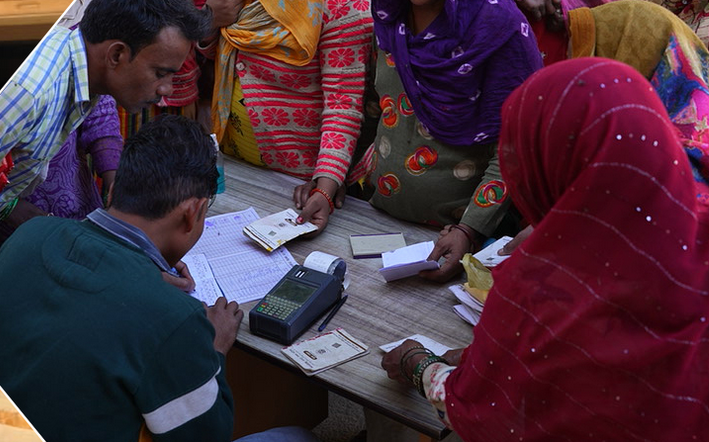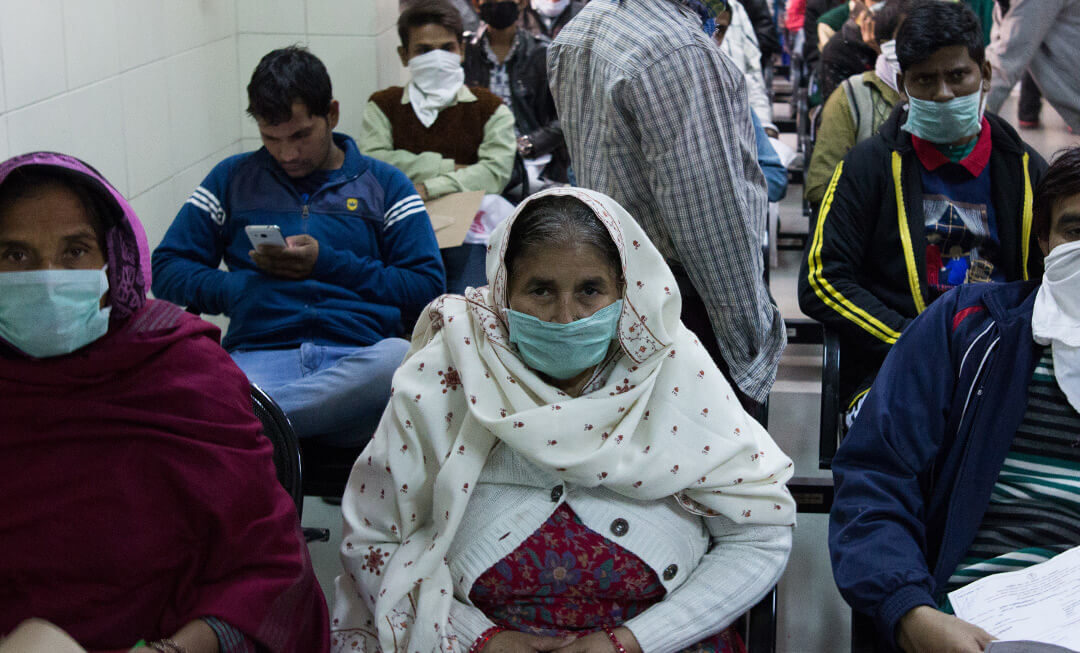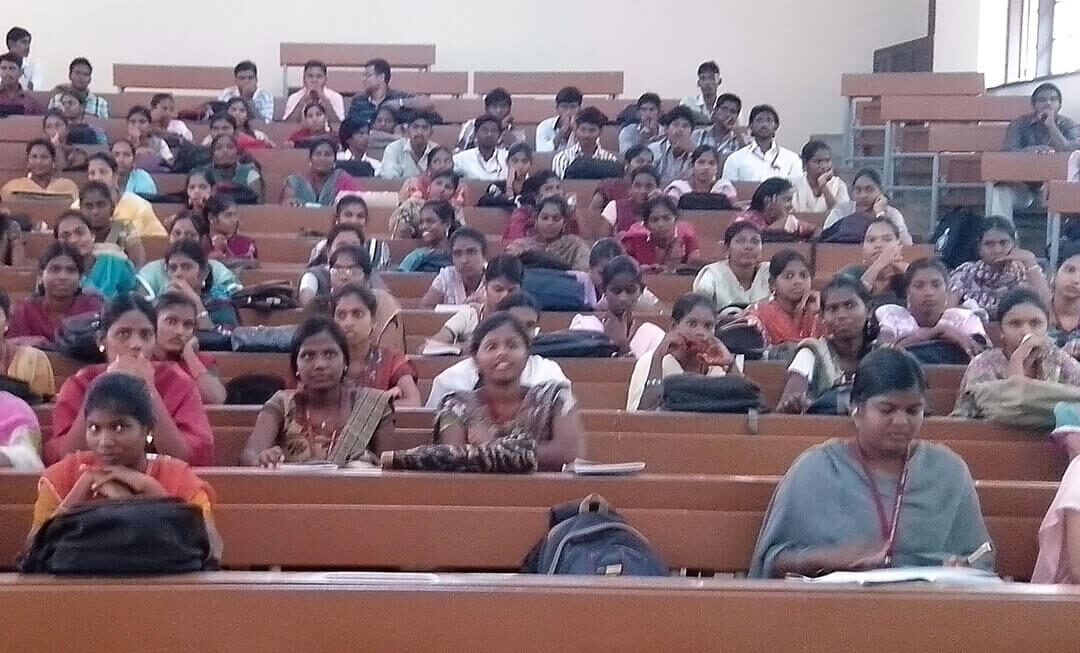1.0 Introduction
Historically, formal education has been the privilege of the upper classes, and in the Indian sub-continent, of the highest castes. The ancient legal text Manusmriti prohibits the Shudras and women of all castes from acquiring formal knowledge; in fact, even hearing the verses of enlightenment was a crime inviting severe punishment. By contrast, the present-day establishment appears to uphold the necessity of education for the masses.
The concept of a system of universal modern education originated in Europe in the 19th century, with the rise of the factory system of production. In an article provocatively titled “The modern education system was designed to teach future factory workers to be punctual, docile, and sober,” the author lays out the reasons for the capitalist class’s interests in pushing for universal education:
The transition to factory work was unpleasant, to put it mildly. The idea that men had to show up and take orders from a boss—someone they were not even related to—was demeaning and emasculating. Factory conditions were often terrible and completely changed how people organized their days. Time was no longer their own. Economists Oded Galor and Omer Moav argue that Prussian factory-style schools caught on across the West as the spread of industrialization created a need for compliant, literate workers. Industrialists led the charge to adopt universal education in the US, UK, and elsewhere in Europe. Factory owners were among the biggest champions for the Elementary Education Act 1870, which made education universally available in England.
The purpose of education was not to impart technical skills; on the contrary factory system systematically deskilled the workers. As economist Joel Mokyr explains:
Much of this education, however, was not technical in nature but social and moral. Workers who had always spent their working days in a domestic setting, had to be taught to follow orders, to respect the space and property rights of others, be punctual, docile, and sober. The early industrial capitalists spent a great deal of effort and time in the social conditioning of their labor force, especially in Sunday schools which were designed to inculcate middle class values and attitudes, so as to make the workers more susceptible to the incentives that the factory needed.
As the working-class movement strengthened, workers organised to use education as a means to wrest rights and dignity for themselves. And when women workers started to actively participate in the trade union movement, they pushed for strict implementation of the abolition of child labour, which was rampant in American industry right up to the 20th century. Women’s demand for compulsory public education for children and the passage of laws to enforce it was instrumental in abolishing child labour in developed countries.
For over a century, literacy has been a key signifier of development of a population. The Human Development Index (HDI) identifies education as a key dimension of human development. Having surpassed the GDP of the UK to become the 5th largest economy, and becoming the 4th country to achieve a ‘soft’ landing on the moon, India is being hailed as a 21st century’s unstoppable superpower by the global media. The country’s population surpassed that of China in 2023, making it the most populous in the world, and with more than half its population under 30 years of age, India is supposed to be ideally poised to reap its demographic dividend.
And yet its stunted and malnourished children, equipped with only limited literacy, seem to be stubbornly unwilling to ‘cooperate’ in this lofty endeavour. India’s HDI ranking puts it at 134th position, making a mockery of the aforementioned claims. The rulers of the country hope to overcome the detrimental policies and inadequate investment in public education of over 75 years through a revolutionary transformation: privatising and digitalising the entire sector, from school to higher education.
In this piece we limit our discussion only to school education. We start with an overview of the existing school system in India, and then dwell on digitalisation efforts through Government policies, private sector and NGO interventions and their impact on students, parents, teachers and others.
2.0 Overview of the School System in India
There are around 37 crore (370 million) children in India in the age group of 3 to 17 years, which means every fourth person of our country is of school-going age (including three years of pre-school). There are about 26 crore (260 million) children enrolled in school from pre-primary to higher secondary level, indicating that around one in three children of school-going age is not enrolled in school. The Government’s data base on schools, UDISE+ 2021-22, states that the national General Enrolment Ratio (GER) up to the elementary level of school (up to class V) is almost 100 per cent. However, the GER reduces drastically at the secondary level, and at the higher secondary level only one in two children is enrolled in school. The school level education can be divided into two broad categories – formal, which is enrolment in a school in public or private sector, and informal, which usually supplements the formal, in the form of pre-school (playschools and Anganwadis), private coaching and tuitions – both online and offline.
As shown in Table 1, there are 14.9 lakh schools in the country, catering to 25.6 crore enrolled children. Of these, just over 10 lakh schools, or 70 per cent of schools, are Government-run, around 3.36 lakh schools are private unaided, and over 82,000 schools are Government-aided private schools. There has been a steep rise in the number of private schools in the last three decades.
Table 1: Overview of the Formal School System of India
| Government Schools | Private Unaided Schools | Total Government Aided Schools | Other Schools | Total Schools |
| 1. Schools (’000) | 1022 | 336 | 82 | 50 | 1490 |
| as % of Total | 68.6 % | 22.7 % | 5.5 % | 3.3 % | 100 % |
| 2. Students – Primary to Higher Secondary (’000) | 140,499 | 82,450 | 26,648 | 5,874 | 255,741 |
| as % of Total | 55% | 32.3% | 10.4 % | 2.3% | 100 % |
| 3. Average Students per School | 138 | 246 | 325 | 118 | 172 |
| 4. Teachers (’000) | 4,882 | 3,541 | 797 | 287 | 9,507 |
| as % of Total | 51.4 % | 37.2% | 8.4% | 3 % | 100% |
| 5. Student to Teacher Ratio | 28.78 | 23.28 | 33.43 | 20.47 | 26.9 |
Source: UDISE+ 2021-22, pp 23-25
In 1978, only 3.4 per cent of children were enrolled in private schools, and three-fourths of school-going children were in Government schools. At present almost half of all children are enrolled in private and private aided schools. There seems to be a general perception that private schools offer better learning outcomes for students. Reportedly, “73% of parents report that they prefer private schools because they want better learning for their children.” There appears to be a clear divide among urban and rural school going children – while 27 per cent of rural children go to private schools, over 70 per cent of urban children attend private schools. It seems like an anomaly that, in a country where a significant percentage of the population barely manages a subsistence level income, people have been opting for private school education.
2.1 Push for Privatisation of Schools
The drive for privatising Indian school education has been under way for over three decades, especially since the economic liberalisation of the country in 1991. Over decades, various agencies – private sector, non-profit organisations, influential foundations, think tanks, academics and others – have built up a lot of criticism, disparaging the entire Government schooling system. But arguably the most significant impetus came from the World Bank, which veritably governed the country’s education policy after India signed the Jomtien Declaration in 1990. The first intervention by the World Bank was the District Primary Education Programme (DPEP) in 1993. Implemented in eighteen states, the DPEP led to the veritable collapse of the existing primary school education system and paved the path for private players. After a decade of the DPEP, the World Bank pushed for the implementation of Sarva Shiksha Abhiyan (SSA) from 2002, with the mandated goal of universalising elementary education — without any analysis of the earlier programme. This second intervention of the World Bank intensified the systematic dismantling of the public schooling system for the two decades it guided the education policy of the country. Significantly, the World Bank was allowed to dictate the education policy of the country, in spite of providing less than 2 per cent of Government expenditure on education.
These interventions had two important features which laid the ground for private players to dictate the course of school education in India.
- With rising budget deficits and shortage of funds, instead of prioritising school education and mobilising public funds, the Government, both in the Centre and the states, sought financing from international development organisations. This was facilitated by the IMF-World Bank Structural Adjustment Programme (SAP), which pushed for withdrawal of the State from all social sectors.
- The rapid expansion of education led to a high demand for teachers to fill newly opened teaching positions. And yet, given the strictures against incurring extra costs, the state governments resorted to employing contract or ‘para’ teachers to fill these posts.
And finally, all resistances offered from within the school system were thwarted by the judiciary, which consistently passed judgments favourable to the expansion of low-cost private education.
These developments have been steadfastly resisted by activists, educationists, scholars and people who have been demanding for implementation of universal education as a fundamental right. The basic principle the Right to Education movement fought for was an education policy which provides education of equitable quality to all children without any discrimination whatsoever. And yet the ‘Right of Children to Free and Compulsory Education Act’ (RTE Act, 2009) made no attempt to engage with the extreme inequality of the Indian society, and reinforced the existing multi-layered education system. As stated by an academic and a longtime Right to Education activist:
The Right to Education Act, 2009, which legislated a quota of at least 25 per cent for students belonging to the Economically Weaker Sections in admissions to private schools, functioned as a Trojan horse that set up privately funded school education as a desirable option and failed to emphasise its inherently defective pedagogical character that fuses quality in education with the capacity to pay.
In 2017, the Government of India’s apex policy think tank, the NITI Aayog, issued a report titled ‘Three-year Action Agenda’, recommending radical reforms for what it termed ‘non-performing’ or ‘hollowed-out’ Government schools. NITI Aayog recommended handing over Government-run schools to private players in a public-private partnership (PPP) arrangement. The private entities would manage the schools while the Government would fund them on a per-child basis. The detailed report laid out three crucial reasons for recommending such drastic measures:
- Massive migration from Government schools to private schools. Apparently, between 2010 and 2014, Government schools saw a dip in enrolment by 1.13 crore, while enrolment in private schools grew by 1.85 crore during the same period. The primary reason, according to the Aayog, was the dismal ‘educational outcomes’ of Government schools.
- NITI Aayog lays the entire blame of the state of public school system on the teachers: “High rate of teacher absenteeism, limited time spent on teaching when the teacher is in class and generally poor quality of education are among important reasons for this emptying out (of students). Outcomes (educational) are worse in government schools than those privately run, and those who can leave are voting with their feet.”
- The clinching argument is the high burden on the exchequer of footing the bill of salaries of such inept teachers. Apparently, there were 3.7 lakh Government schools with less than 50 students each in 2014-15: “The average [number of] student[s] per school stood at 29 with the expenditure per child coming at Rs 40,800, besides the total (annual) teacher salary bill coming at Rs 41,630 crore during 2014-15.”
Such quantifying observations, especially couched in academic language, seem to give added sanctity to simplified claims made about such a complex situation. Geeta Kingdon, in a discussion paper titled “The Private Schooling Phenomenon in India: A Review”, combines inputs from ASER on learning levels of students in public and private schools with the evidence on per pupil expenditure (PPE) in public and private schools to make a comparative statement on ‘value for money’ (VFM) offered by public and private schools. To quote from the paper:
While in Bihar, Tamil Nadu, Punjab and Orissa, private schools are roughly twice as cost-effective (offer twice as much VFM) as public schools, in Gujarat, private schools offer 12 times as much VFM as public schools, and Uttar Pradesh is an outlier, with private schools there offering 29 times as much VFM as public schools.
We will discuss the issue of learning outcomes in the next subsection, but the entire premise of the value for money (VFM) and the remarkably better performance of private schools over public schools is based on the pittance paid as a salary to private school teachers. The concept of efficiency in what is nominally acknowledged to be a public good, namely universal free school education, has itself been reduced to the cost per child or ‘economic’ efficiency. Even such a simplistic assessment of superior efficiency hinges on the shamefully inadequate salaries of private school teachers. Apparently, a private school teacher’s salary in Bihar and UP was merely 8 per cent of that of a Government school teacher, and the average salary of a Government primary school teacher in rural Punjab in 2014 was Rs 59,654 per month; a private school teacher’s pay, at Rs 1,925, was only 3.2 per cent of a Government school teacher’s pay.
Kingdon argues that the Government teachers’ pay is a ‘bureaucratically-set’ high ‘minimum wage’ influenced by ‘political pressures’ and ‘strong unions’, while private school teachers are paid a ‘market-determined’ wage. It is revealing that a salary of Rs 1,925 per month for teachers could be attributed to market efficiency, and lauded for contributing to the cost-effective performance of private schools. Kingdon further emphasises this point by comparing the salaries of Indian Government school teachers with their international counterparts. Apparently an Indian teacher’s salary is a much higher multiple of India’s per capita income than a Chinese teacher’s salary is of Chinese per capita income. Yet China’s students rank 2nd worldwide, while India’s students rank 73rd out of 74 countries. The major recommendations of the paper include a PPP model for running Government schools, linking future increases in Government teachers’ salaries to accountability, and a moratorium on creating new Government schools. There are of course no recommendations about revision (upwards) of private school teachers’ salaries, even though they are much lower than per capita incomes.
A much-cited report titled State of the Sector Report: Private Schools in India by Central Square Foundation (CSF) and Omidyar Network India (ONI), two extremely influential private non-profit foundations, make a case for bolstering the private school sector, as almost half the students already attend it. The report mentions several regulatory and oversight measures for private schools, including loosening some existing guidelines. On the issue of the salaries of teachers in these schools, the report argues that “across the board salary hikes are found to have no or small effect”, and recommends that private teachers’ salaries should not be benchmarked with Government teachers’ salaries.
Even Government schools have been increasingly relying on para-teachers and contractual teachers for several years now, who are paid a fraction of regular teachers’ salaries and are posted in the most disadvantaged and poorly resourced areas. The National Education Policy (NEP) 2020 proposes hiring of a large number of teachers in the near future to fill the gaps and ensure adequate teacher-student ratio in schools. But since the document makes no statement on equal service conditions for all teachers, they will most likely be contractual recruits.
Besides the rise of the private school sector, there has been a consistent push for privatisation of Government schools. At the launch of the ‘Vidyanjali 2.0’ in 2021, the Prime Minister said:
… (it is) a platform for the country’s resolve of ‘Sabka Prayas’ with ‘Sabka Saath, Sabka Vikas, Sabka Vishwas’. In this society, our private sector has to come forward and contribute to increasing the quality of education in government schools.
In September 2023, the Maharashtra government passed a resolution allowing state-run schools to be adopted by the private sector. The state has 62,000 schools catering to 50 lakh students. 51,000 government schools were shut down between September 2018 and September 2019 across the nation; the number of Government schools fell from 1,083,678 in 2018-19 to 1,032,570 in 2019-20.
Thus, by an extraordinary distortion of policy, from a public good requiring the Government to allocate resources, school education is being converted into a money-generating private enterprise. The CSF and ONI report on private schools in India states that the sector earned Rs 1.75 lakh crores, according to UDISE 2019, and this sum is likely to have gone up significantly in the intervening five years. As long as extreme inequality and lack of employment exist in the country, the majority of people would keep spending a substantial part of their meagre household earnings on their children’s education, in the hope of their escaping the cycle of poverty.
2.2 Learning Outcomes in Indian Schools
There are several large-scale surveys trying to determine the status of learning in schools in India. It is universally reported that the majority of children have been successfully enrolled into some form of school, at least at the primary level. The National Achievement Survey 2021 indicates that the average scores of children in the country from class III to class X are about 50 per cent, as can be seen in Table 2 below.
Table 2: Average Performance of Students in Class III, V, VIII and X (Scores out of 500)
| Subject | Class III | Class V | Class VIII | Class X |
| Language /MIL | 323 (64%) | 309 (61%) | 302 (60%) | 260 (52%) |
| Mathematics | 306 (61%) | 284 (56.8%) | 255 (51%) | 220 (44%) |
| EVS | 307 (61%) | 203 (40%) | | |
| Science | | | 250 (50%) | 206 (41%) |
| Social Science | | | 255 (51%) | 231 (46%) |
| English | | | | 277 (55%) |
| Total | 312 (62%) | 265 (53%) | 265 (53%) | 239 (48%) |
Source: National Achievement Survey 2021, p.7
Probably a more accurate picture may be gleaned from the Annual Status of Education Report (ASER), which focusses on rural India, where 70 per cent of Indian families reside. The report claims that only one in five children in class III can read at grade II level, and one in four children can do arithmetic at grade II level. Things are dire even at higher grades, as is evident from Table 3 below – only two out five children in grade VIII can do a simple division appropriate for grade II. The learning status has remained stagnant for a decade, and even declined marginally. This is in spite of all the high-profile policy interventions by the Government and private players including non-profits, philanthropies, foundations, think tanks, well-meaning individual efforts, etc.
Table 3: Percentage Children Enrolled in Government Schools Who Can At Least Perform Division: 2012-2022
| 2012 | 2022 |
| Grade V | 20.3 % | 21.6% |
| Grade VI | 28.9% | 27.4% |
| Grade VII | 38.1% | 34.0% |
| Grade VIII | 44.5% | 41.8% |
Source: Annual Status of Education Report (ASER) 2022, p.18
2.3 How India Funds its Children’s Education
According to the Economic Survey of India 2022-23, the combined Centre and State public expenditure on education is barely 2.9 per cent of GDP; in fact the expenditure on the entire social sector is barely over 8 per cent of GDP. The grand Samagra Shiksha Scheme of Central government, which is an integrated scheme for school education covering the entire gamut from pre-school to class XII, has a budget allocation of Rs 37,383 crores. This translates to Rs 1,407 per child per annum if only the ones enrolled are counted (26 crores) or Rs 1,010 per child, if the entire population of school-going age (37 crores) is taken into account. Samagra Shiksha’s Sustainable Development Goal for Education is “by 2030, ensure that all boys and girls complete free, equitable and quality primary and secondary education leading to relevant and effective learning outcomes”. That seems like a very tall order at an allocation of Rs 2.80 to Rs 3.90 per day per child! Of the total education budget of around Rs 7.5 lakh crores, the bulk is shouldered by the states, and the Centre contributes just over Rs one lakh crore. Given that teachers’ salaries constitute a substantial part of the expense, ranging from 70 to 90 per cent of the budget, there is precious little left for anything else. Further, most states have been reducing their education budget in percentage terms over the last few years in spite of the devastating impact of pandemic on education over these years.
2.4 Household Expenditure on Education
An Economic Times online survey conducted on estimated education costs for children raised in metros declared the “cost of raising a child in India: school costs ₹30 lakh, college a crore”. In fact the total expense to raise a child through college is modestly estimated to be Rs 1.3 crores, as shown in the graphic quoted from the article below. To put it in perspective, that is equivalent to 681 months (57 years) of salary of an urban male regular worker; a casual male worker would be required to work for 152 years to raise the child. Not only there are two Indias, but the twain are galaxies apart.
Figure 1: Cost of Raising a Child through Higher Education in a Metro in India

As we have seen above, the public funding for education has been very inadequate in spite of the rhetoric. Thus the remarkable achievement in expansion of education, specifically enrolment, can be attributed to private household spending. Parents still believe that education would provide a ticket to their offspring for a better future. As is apparent from Table 4 below, from an article by C. P. Chandrasekhar and Jayati Ghosh, education probably is the single largest expense for most households, accounting for as much as 40 per cent of an average urban casual labourer’s wages.
Table 4: Monthly Spending on Education (Rs) Relative to Income

Source: Unaffordable Education in the New India
3.0 Strategy of the State to Address Problems of Education Sector: NEP 2020
The ruling dispensation of the country and its elite are convinced that India is on the brink of being a superpower, and the international and national media agree. Prime Minister Modi keeps repeating that India has donned the mantle of ‘Vishwaguru’ by taking a leadership role in global affairs. Hence it is a veritable embarrassment that the majority of its children (and adults) are barely literate. In fact, as a recent book elaborates, India’s much poorer neighbours are doing way better than some states in India on a range of social indicators such as health, education, nutrition, and sanitation.
The leadership of this country is bent upon changing this ‘reality’. They claim that the NEP 2020 embodies their ‘new’ vision of how to attain it. The goal is to “ensure inclusive and equitable quality education and promote lifelong learning opportunities for all” by 2030. For that the policy states that, “the gap between the current state of learning outcomes and what is required must be bridged through undertaking major reforms that bring the highest quality, equity, and integrity into the system, from early childhood care and education through higher education.”
Though the policy has set lofty goals regarding education to be achieved in the next five to seven years, the present national budget has allocated barely 2.2 per cent of its Rs 45 lakh crore total outlay on education, and barely 0.8 per cent on its flagship scheme for the integrated school education, Samagra Shiksha.
The document is laden with such noble intentions that there is not much to disagree with, hence the miserly allocation of resources seems inexplicable. But if one connects the developments on the ground in the education sector over the last few years, the underlying objective of the NEP document seems to indicate a definite policy thrust. State and various state agencies concerned with school education and education at large are active partners and facilitators towards privatisation and a wholesale adoption of edtech, i.e., use of information and related digital technology for education.
The NEP 2020 document and its authors seem to consider ‘digital’ as an elixir for all problems. A simple search reveals that ‘online’ is mentioned 50 times, while ‘digital’ finds 38 mentions in the 60-odd pages of the document. In part III, on ‘key areas of focus’, one chapter is devoted to the use of technology, while another to online and digital. From Pali to Persian to vocational training to teachers’ transfers, all of this can be done remotely through the online-digital mode, according to the NEP 2020.
If we read between the lines, the idea of education is to somehow teach and learn some tricks to find gainful employment. Application-based learning and vocational training find repeated mentions, and that too mostly can be delivered online, as per the policy document. So, if the schools do not have labs, and this is true of a very large number of schools and colleges in the country, resulting in very poor science education, it is not a problem; the students can work with ‘virtual labs’. Given the central position of digitalisation in NEP, the ‘vision’ of the policy makers is obvious as reflected in section 4.46, p20:
Once internet-connected smart phones or tablets are available in all homes and/or schools, online apps with quizzes, competitions, assessments, enrichment materials, and online communities for shared interests will be developed, and will work to enhance all the aforementioned initiatives, as group activities for students with appropriate supervision of parents and teachers. Schools will develop smart classrooms, in a phased manner, for using digital pedagogy and thereby enriching the teaching-learning process with online resources and collaborations.
If we look at the big picture here of the role of the State, its agenda is very limited despite all the rhetoric to the contrary. The objective of its system of schooling is not to invest in making citizens fit for a 21st century ‘democracy’ or a ‘superpower’, as the rulers claim. It is not even really to create economic agents who can contribute to the economy. The rulers are aware that the opportunities available for economic mobility are extremely limited, apparent from the promise of continuation of free rations for five more years as their prime electoral sop. It appears that the State is very clear about its extremely limited objectives in spite of the impressive and proliferating list of acronyms and programmes emerging from the NEP 2020. For example, FLN (Foundational Literacy and Numeracy), spearheaded by NIPUN (National Initiative for Proficiency in Reading with Understanding and Numeracy) Bharat mission, in simple language means the ability to read barely a few sentences and do minimal arithmetic operations. The Government thinks that this can be best achieved through relying on edtech – which is cheap, has wide reach and requires low investments in teachers and physical schools, even as it provides tight control over school managements and teachers.
3.1 Thrust for Digitalisation in the Making Over Years
The 2021-22 Report on UDISE+ claims that the national Gross Enrolment Ratio (GER) up to elementary level of school (first 8 years) is almost 100 per cent. Further, the report claims that essential infrastructural facilities are more or less in place in most schools: electricity connections (89 per cent), drinking water facility (98 per cent), toilet facility (99 per cent), and even playground facilities (77 per cent) . The only parameters which fall short are computer equipment (47.5 per cent) and internet facility (34 per cent). This fits in neatly with the plan to fix the state of education in India. The Government believes that all that is needed for schools can be delivered, monitored, controlled and improved through digitalisation, and it has therefore invested heavily in impressive-sounding portals and programmes.
A systematic shift for both control of schools and teachers, as well as delivering classes through the digital mode, has been in the making for a while, and Covid provided a great opportunity to implement it on a large scale. In 2012-13 the Government launched the Unified District Information System for Education Plus (UDISE+) that it claims to be “one of the largest Management Information Systems”, covering more than 14.89 lakhs of schools, 95 lakhs of teachers and 26.5 crores of children. It claims that one can log on to the site and get detailed information regarding any school in the country. In 2017, NCERT launched DIKSHA (Digital Infrastructure for Knowledge Sharing), a national platform for school education using open-source SunBird (from EkStep, see section 5.0 for details) which contains textbooks, online courses, interactive quizzes, question banks, chatbot, analytics, dashboard, etc. During the pandemic DIKSHA launched NISHTHA (National Initiatives for School Heads and Teacher’s Holistic Advancement), supposedly a ‘massive’ professional development programme for teachers as well as school management and administration. NCERT also now claims to deliver content for students on a 24×7 basis through PM eVIDYA DTH-TV channels (One Class, One Channel from classes I to XII). These channels deliver class-wise contents in a number of languages that are linked to DIKSHA through QR codes.
Most of the reports on the status of education sector by academics, government, philanthropic institutions, corporate sector, and private bodies acknowledge that the general state of education in the country is dismal and needs urgent attention. But all these analyses do not make any attempt to acknowledge either the complex social reality of an unequal society and the incoherent, muddled and miserly plans and policies over the last eight decades which are responsible for this scenario. Instead, under all the verbiage of noble goals and lofty interventions, the responsibility for the state of affairs in schools seem to have been attributed to the three core actors affected by it: children, teachers and parents. It has been universally agreed by all those in decision-making positions that technology would fix these three. Of course, none of these core actors has been consulted to any extent in this entire process – from diagnosis to prescription.
A recent report titled Education 4.0 India INSIGHT REPORT brought out by the World Economic Forum, UNICEF and YuWah! Generation Unlimited, encapsulates the policy agenda of the rulers for the education sector of the country. Quoting from the preface of the report:
Despite significant strides in the field of education, India continues to report poor learning outcomes among schoolchildren. The National Achievement Survey of 2021 found nearly half of primary school students to have learning levels lower than appropriate for their grades, a situation that the pandemic has intensified. This has far-reaching implications for young Indians’ readiness for the 21st century workplace and India’s preparedness for the Fourth Industrial Revolution.
The Knowledge and Information Network for Digital Learning and Education (KINDLE) is an initiative to utilize digital and other technologies to address learning gaps and make education accessible to all. A joint effort of the World Economic Forum, UNICEF and YuWaah (Generation Unlimited in India), it proposes solutions that align with, and hence augment and amplify, India’s National Education Policy (NEP) 2020 and the National Digital Education Architecture of 2021.
3.2 Errant and Simple-minded Children
As has been stated above, in spite of nearly hundred per cent enrolment till grade 8, the ‘learning outcome’ has been pathetic, with grade 5 children struggling to read or do simple arithmetic appropriate for grade 2. It does not occur to the experts that there could be something deeply flawed in the form of education or process of evaluation, or that these children may be proficient in knowledge which cannot be learnt as undifferentiated robots and needs application of a kind that cannot be discerned by such simplistic measures. There is no attempt to know or understand these children and discover their uniqueness or potential. The Annual Status of Education Report 2023 provides data regarding the gross inequality in our society outside the school. 82 per cent of girls and 64 per cent of boys in Standard 10 or below have to perform several hours of household work daily. One-third of rural children in the age group of 14-18 years spent at least 15 days a month doing work other than household work to support the family’s precarious economic situation. Most of them work on their family farms, and also on contractual work such as beedi rolling. As a recent article on ASER 2023 points out:
These children’s lives are hard. They have real and important responsibilities outside their school hours. In this context, how can children’s learning levels be addressed without taking a hard look at other inequalities? Will this data spark conversations and deliberations on economic policies and social safety nets? Or will it only concern those interested in curriculum, pedagogy, school infrastructure and learning outcomes?
There also seems to be an assumption that these children are largely incapable of understanding the big picture or the complex reality. With this grim diagnosis the prescription has been to offer ‘Byte-sized learning content’ so that it is easily digested by the children.
3.3 Irresponsible, Untrained and Overpaid Teachers
The next set of actors who have been held responsible for the state of school education in India are the teachers, specifically Government school teachers. As shown in Figure 2 below, from the State of Sector Report for Private schools, in 1978 three-fourths of children were enrolled in Government schools, and even today 70 per cent children in rural areas are enrolled in public schools. The significant migration to private unaided schools since then has been attributed to the irresponsibility of the teachers of Government schools.
Fig 2: Growth of Government School Enrolment over the Year

Source: State of the Sector Report on Private Schools in India, p. 22
This decision by parents and guardians is significant, as not only are the fees higher in private schools, but they have to forego support extended to Government school children such as mid-day meals and direct beneficiary transfers towards uniforms, etc. It is widely claimed that private school teachers deliver better outcomes in spite of getting a fraction of salaries. That is the reason why the policymakers and other related agencies have been pushing hard for not only promoting private schools but also for the privatisation of Government schools. They of course foresee not only better learning ‘outcomes’ but also massive savings from the Government budget, as all the cost would be privately borne by the parents.
Ridiculously ‘cheap’ teachers obviously come with inadequate qualifications. But influential think tanks like CSF and Omidyar Network believe that the qualifications of teachers are not of much consequence for ‘learning outcomes’, and hence one can cut down on the number of teachers and settle for cheap under-qualified teachers. “Learning oriented requirements are largely input-driven and focus on the numbers, qualifications and salaries of teachers – factors which may not be linked to actual outcomes”.
Given that the role of teachers has been reduced to merely administering pre-designed byte-sized contents of learning to their students, almost no qualification is required for teaching as envisaged. Perhaps the most extreme form of this thinking is exhibited in the kind of teaching manuals that have been prepared by some of the non-profits in recent years, and that are being used very widely in at least the Government schools across the country. It is almost a minute-to-minute drill for every period, every day, with weekly, monthly, and annual plans. These are being delivered to teachers, school managements as well as parents, now through apps, phones and other such digital channels, and are being monitored too. Schools have always been a hunting ground for Taylorisation, but with the digital technology and such minute-to-minute monitoring, this has been taken to another level. Organisations like CSF (more about CSF in section 5.0) have been instrumental in creating such teaching and training manuals and a sample of such manuals that a number of non-profits are creating can be found on their website.
So if the children are slow to learn and teachers irresponsible, what is the solution? The policymakers have decided to make the classrooms smart instead.
75-inch touch-screen panels, hi-def web cameras, digital course content, internet connectivity set to revolutionise classroom teaching…Overall, the UP government plans to make teachers and students smart along with smart classes, an official said.
At present various kind of responsibilities are dumped on Government school teachers, including maintaining numerous registers. Apparently, an average school in Uttar Pradesh maintains a list of over 30 registers! It was estimated that a teacher was left with only 13 hours of teaching activities in a 35-hour week; the remaining 23 hours were spent on non-teaching activities and tasks, as shown in Figure 3. Digitalisation will also enable tight monitoring of teachers with suitable punitive measures. Already the UP government has initiated digitisation of 12 registers:
The registers that will be digitized include the attendance register, entry register, class-wise student attendance register, MDM (Mid-Day Meal) register, integrated free material distribution register, and a stock register. Additionally, registers for income and expenditure, issuing checks, conducting meetings, inspections, correspondence, and counting children, libraries, and sports will also be digitized. This move will enhance transparency and data manipulation will not be possible.
Further, the Government has announced that the primary school teachers and principals would now be subjected to ‘Corporate Appraisal System’ apparently to reduce corruption in the system. For promotions and raise in salaries, teachers are now required to fill an online self-evaluation form that would gauge their performance across nine parameters.
Fig 3: Teacher Time Spent on Non-teaching Tasks: Analysis over 1 week

Source: “For government school teachers, time is of the essence.”
3.4 Parents’ Aspirations: Lottery through education
India has over a billion people in the working age group, but barely 48 per cent of them have any form of employment; 528 million are completely out of the workforce – that is, they have either stopped looking for work or are unemployed. Among those who claim to have some form of employment around half (43 per cent) are stuck in agriculture, which contributes barely 15 per cent to the GDP, indicating compulsion rather than choice. This is corroborated by the kind of jobs available in non-farm sector. According to the State of Working India 2023, of the remaining 282 million employed in the non-agricultural economy, 170 million (61 per cent) are in the ‘subsistence’ sector engaged in self-employment or casual wage work. And barely 11 crore workers are engaged in regular wages or salaried work.
Given this dire situation, most people believe that education is the only lottery ticket for their children to a better future, to avoid being stuck in their parents’ situation of immobility and poverty. The reality defies such expectation though, as the State of Working India 2023 report highlights: “unemployment remains above 15% for graduates and more worryingly it touches a huge 42% for graduates under 25 years.” Predictably, the shift to a semblance of regular jobs is most difficult for the most vulnerable sections of the society. Over three-fourths of workers belonging to Scheduled Castes/Scheduled Tribes category at present are forced to continue in the same occupation as their parents. ASER 2023 also indicates that vocational work is not the primary work aspiration of rural children (14-18 years), and over 60 per cent of those enrolled in any education institution aspire to continue studying.
Most of the self-employed and casual workers are trained through informal apprenticeship processes, with knowledge passed on from one generation to the next. The National Education Policy 2020 seems to aim merely to give it a ‘formal’ cloak. With the introduction of vocational training from 6th grade onwards in school in the name of skilling, it appears to endorse the continuation of the next generation in same or similar occupation, albeit with ‘formal’ training through digital means. Towards this end the Finance Minister announced the launching of DESH Stack e Portal in the budget of 2022-23 and has apparently launched it in November this year. According to the official website of the portal,
The main objective of the DESH Stack e Portal is to provide skilling, upskilling, and reskilling opportunities through API-based platforms. Through this portal, citizens will be skilled so that they can earn their livelihood. This portal will also help discover relevant jobs and entrepreneur opportunities. With the help of this portal, employment opportunities will generate which will reduce the country’s unemployment rate. The citizens of the country will become self-dependent.
Thus, apparently, the policy makers believe that substituting the existing skill impartation through ‘informal’ on-the-job apprenticeships with digital skill impartation would address the gigantic shortfall of employment opportunities for the ever-increasing numbers seeking employment. Providing digital skilling would absolve the people in authority of any responsibility to provide dignified employment. Basically, people were ‘self-dependent’ earlier too, and the Government and policy makers believe they should continue to be so. The only difference would be that the existing means of imparting vocational skills would get delegitimised, and people would have to pay to acquire digital certificates for getting the same or similar employment.
As detailed earlier, private schooling sector revenues are Rs 2.5 to 3 lakh crores and are growing aggressively. This is what households are shelling out for children’s education from their meagre earnings through multiple precarious employments by several members of the household. Their hope is to give their children a golden ticket to a stable job with dignified income. These households would shell out even more to get formal ‘digital’ skilling, but this is unlikely to get their children the desired employment. Most would definitely not have the resources or opportunity to go for higher education and would have to settle for a ‘self-dependent’ precarious existence. History has told us which sections of the society would be confined to that option.
4.0 Promise of ‘edtech’ and India Inc.: Capital’s interests in digitalisation of education
‘Edtech’ has been propped up as an answer to all the existing problems in education and learning. Its proponents claim that it provides the masses cheap or even free education of high quality. They claim that it is productive and efficient and yet can be customised to cater to the needs of an individual, by offering freedom to learn as per one’s need and pace. It is interactive, and it can hence fulfil the needs of a range of disadvantaged and marginalised groups globally. To quote New York Times columnist Thomas Friedman, gushing about edtech a decade back, “(n)othing has more potential to lift more people out of poverty”. In his assessment, it has a “potential to unlock a billion more brains to solve the world’s biggest problems”, as “for relatively little money, the US could rent space in an Egyptian village, install two dozen computers and high-speed satellite Internet access, hire a local teacher as a facilitator, and invite-in any Egyptian who wanted to take online courses with the best professors in the world, subtitled in Arabic.”
Another ardent votary of edtech claims, “(Google) will analyze the oceans of information being generated by millions of students and continually optimize and improve what students experience and how much they learn…Colleges should start thinking about smaller amounts of money multiplied by much larger amounts of people” even if producing a course is expensive. Basically, teaching and learning a course is envisioned similar to a movie being screened for a large audience, with low costs involved in making innumerable copies of it. The promoters of edtech claim this to be a dawn of ultimate democracy; as edX (one of the pioneers of edtech) C.E.O. Anant Agarwal promised, edtech would be “borderless, gender-blind, race-blind, class-blind and bank account-blind.”
Popular media in India too are filled with the promise of edtech citing countless reports and experts. An op-ed column by a Member of Parliament encapsulates much of the claims made about the edtech industry, which ostensibly will “take India to the world.” It is claimed that there are over 4,450 edtech start-ups in India that are assisting a substantial over 300 million school students by tailoring to their individual needs (based on their past data) at their pace and time, catering to the most disadvantaged, and hence making a huge difference to their ‘success rate’.
In recent years the edtech sector has seen exponential growth, of course massively boosted by the absolute and extended lockdown during COVID. A recent Inc42 report states that the sector has more than 5,000 start-ups that have raised $11 billion in funding from some of the most active global venture capitalists, private equity funds as well as sovereign funds. More than half of that sum has been invested in ‘K12’ (kindergarten to class 12). In 2022 the market was $4.6 billion ($2 billion in K12 and $1.4 billion for competitive test preparation). It is estimated to grow at more than 25 per cent per annum and become a $29 billion market by 2030. At present the industry claims to have 18.5 million paid users (3.9 million for K12 and 5.2 million for tests), and projects that number to exceed 100 million by 2030.
The edtech sector claims to cover all sorts of learning for almost every type of learner, and also to provide related services for the other concerned actors like governments, school managements and teachers. The services and products range from professing to providing extra-curricular learning to the entire spectrum of the education sector – kindergarten, boards, tuition, competitive tests, courses for colleges, assistance in admissions (including for colleges abroad), placements, and finally reskilling of those already at work. Edtech also claims to provide inputs, hardware and software, management and training tools to schools and colleges, basically everything that we can conceive of concerning education, right on your screen! Many of the players claim to provide inputs in vernaculars as well and cover numerous boards and states across the country.
If we examine this vast landscape of edtech start-ups, there is a discernible pattern. Each of them claims to reach the marginalised, offer better education, ensure empowerment and democracy, and extend to hundreds and thousands of schools and tens of thousands and lakhs of students of every age, from toddlers to college goers. Given the abysmal quality of conventional education and few avenues for mobility other than education, edtech plays on the vulnerabilities and aspirations of the parents and the young.
Edtech in India thus operates under some of the most favourable possible conditions for it to prosper. Further, almost no extra costs are involved in adding ‘customers’ online, once the edtech content is ready, especially with the availability of one of the cheapest and most widespread access of the internet, as exists in India. And yet, since the Covid lockdown got over, there have been large-scale closures, layoffs, and consolidation in the industry, signifying an all-round crisis. Almost all the large edtech companies have been making huge losses, and shockingly for many, their cumulative expenses are several times of their earnings. Physics Wallah (an edtech company) is probably the only notable exception. In 2021 and 2022 there have been more than 30 mergers and acquisitions deals in edtech, led by the market leader Byju’s, which acquired 17 companies. To top it all, players in the edtech sector seem to realise that mere online based technology is simply not working, and each of them is moving into what they call ‘hybrid play’, i.e., combining their online digital education with traditional physical teacher-based classes in some form or the other. This is in sync with the experience of edtech across the globe.
Perhaps no entity represents these contradictions of edtech better than Byju’s, by far the largest of edtech companies. We will briefly discuss below the great rise and then precipitous fall of Byju’s, as a case of the limitations of edtech. Whatever we detail here about Byju’s is also true of many other edtech entities.
4.1 The Magnificent Rise and Precipitous Fall of Byju’s
Founded in 2011, Byju’s was valued at an astounding $22 billion till last year; it was one of the highest valued start-ups in India’s history. Had Byju’s shares been traded on the stock market, it would have been one of the top 40 companies on the Bombay Stock Exchange in terms of market capitalisation, ahead of massive and established companies like Indian Oil and Tata Steel! The company began as very popular physical (i.e. non-digital) tutorial classes by the founder Byju Ravindran. These evolved into Think & Learn Pvt. Ltd., the parent company of Byju’s. At its peak last year, it reportedly had an employee strength of over 55,000, and more than 100 million registered learners globally, with 6.5 million annual paying subscribers.
Massive venture capital (VC) funding helped Byju’s acquire a number of edtech companies across the globe, providing it a stake in all aspects of edtech. To date, Byju’s has spent at least $2.8 billion on more than a dozen acquisitions to expand beyond the original learning app through which it delivered online and recorded classes for test preparation, like JEE and NEET. Through these large numbers of acquisitions, it has put together a range of services that enables it to reach learners of all ages for all sorts of education/ learning needs across the English-speaking world, including in North America, Europe, Middle East, besides India. It acquired WhiteHat Jr for $300 million for school-going children to learn coding and partnered with Disney to produce animations. Further, to get a toehold in the physical coaching business it acquired Akash Education Services for $1 billion.
In addition, over 2021-2022, it has acquired several platforms that offer virtual reality, artificial intelligence, and educational gaming services. Byju’s massive fundings across the decades include investments by some of the most important global VC funds, sovereign funds, and private equities, such as Sequoia, Tiger Global, BlackRock and Chan Zuckerberg. The funding has been predominantly deployed to acquire companies. In 2021, in the middle of the Covid pandemic, Byju’s received funding of more than $2.4 billion, out of which it spent $1.8 billion to acquire five companies, including Akash and Scholr; another five companies were acquired for undisclosed amounts (see the graphics below).
Another interesting aspect of Byju’s is, that contrary to the typical perception of an online edtech platform, it generated a significant 81 per cent of its FY 2021 revenues from ‘hardware’ sales, raising concerns about the characterisation of such sales as ‘edtech’. Its revenue streams span live tutoring fees, income from streaming pre-recorded courses, and proceeds from tablet and SD card sales, primarily catering to those lacking robust internet access. In fact, some reports suggest that all that Byju’s is doing is loading content on tablets that anyway is freely available on sites such as YouTube.
Figure 4: BYJU’S Acquisitions Over the Years

Source: BYJU’S Unveiled. (Data was available only for companies marked in green.)
And yet, in spite of all the favourable circumstances for edtech as listed above, Byju’s, the poster boy of edtech, has been making massive losses all these years. In 2021, during the peak of pandemic, Byju’s ran a loss of more than Rs 4,000 crores, with expenses being three times of revenues. More than a third of these expenses were in advertising and sales promotion. It has made fantastic expenses in sales and brand promotion, from being the main promoter of the Indian cricket team, to be an official sponsor of the FIFA world cup in Qatar, to having Shahrukh Khan as a brand ambassador and Lionel Messi as a global brand ambassador. Each of these deals was for astounding sums worth tens or even hundreds of crores. Reportedly, the FIFA deal was for $30-40 million, and Messi was contracted for $5-7 million per year, while for the cricket sponsorship, Byju spent close to Rs 200 crores per annum. About Rs. 700 crores were spent on legal and professional services in 2021, most likely to secure all the acquisitions that it had done in the year.
Given the messy state of its books, it is not surprising that a very long list of malpractices of the start-up have been reported in various media outlets. While all of them cannot be discussed in this short note, they broadly fall into the following three categories:
- mistreatment of employees – employees are underpaid, overworked, and forced to make false claims to their vulnerable customers.
- making false and exaggerated claims in their advertising that have been flagged by regulating bodies.
- dressing up their accounting books, which may be the key reason for their inability to declare their accounts of FY 2022 till the beginning of 2024.
One can find numerous complaints of unpaid dues of the employees, and their arbitrary firings at the whims and fancy of the bosses. The work culture is so toxic that employees were forced to leave even when there were very few options of jobs available to educated youth, such as during Covid. The employees apparently are pushed to seal the deals with the parents at any costs usually by making the young learners and their parents feel insecure and inadequate. “My last sale was to a driver whose boss gave him a phone,” a former sales associate told Rest of World. The driver only had Rs 700 in his account when he signed up for a subscription for his only child. “[His] boss paid the down payment and deducted it from his monthly salary. … [His wife] said, ‘I’ll work 24/7 for this course.’ That was the day I resigned.” In another report, a former employee recounted, “You have to let go of your conscience and be absolutely shameless to do this job… I (was) so wracked with guilt sometimes, I could barely sleep at night,” as she had barged into people’s homes, shamed them into buying a course for their children, and blocked their numbers if they asked for refund.
One way that Byju’s has managed to seal deals with people who can ill afford their ‘products’ is by tying up with financial partners who are willing to pay them loans. This is another Pandora’s box of malpractices. Parents have little idea of this financial aspect of the deal, and despite promises that one may decline the deal in a trial period, once it is done, the fintech firm, having all the details of the buyer, forces and threatens parents to keep paying the instalments, in complete violation of the privacy of both children and parents.
There have been several strictures against Byju’s advertisements by the regulating authorities. For instance, in one of the ads White Hat Jr, a subsidiary of Byju’s, claims that a seven-year-old can be a TEDx speaker and app developer; in another set of ads it claimed that a pre-teen child had bagged a job worth crores! All these, unsurprisingly, turned out to be false claims.
There have been reports of suspect accounting practices such as capitalising employee costs for some of the technical and content producing teams. The idea is to reduce the expenses in the books and show employee expenses as assets. Also, the sale of education services for several years have been booked in the first year itself, bloating the immediate revenues. Of course, in the absence of substantial increase in the generation of their own revenues, they could use this financial juggling only as long as the liberal VC funding lasted. Probably these are some of the reasons why Byju’s has not been able to declare its results for almost two years. As of the beginning of 2024, the last results that the company has declared were for the FY 2021, even those having been delayed by almost 18 months. In recent times, Byju’s investors have also accused them of non-payment of their dues and siphoning of funds from the subsidiaries.
The fall of the poster boy of start-ups has been as precipitous as its rise, with its present valuation down to a mere $3 billion (from $22 billion) within a year. Reports talk of large-scale retrenchments: its employee strength has apparently been halved. It is reported to be planning to sell off many of its acquisitions. Most recently its auditor, Deloitte, as well as all the three non-family member directors on their board, have quit. Only the three family members of Ravindran himself are now left on the board. Byju’s trajectory epitomises the present crisis of the edtech sector at large.
5.0 Interventions of Non-profits in Edtech
Another large corporate presence in digitalisation of school education, and in some ways even more significant than the edtech start-ups, is that of the so-called ‘non-profits’. Several actors are present here – first and foremost, the foundations funded by the largest of corporate bodies and billionaires, like Bill & Melinda Gates and Nandan & Rohini Nlilekani. The next is NGOs funded by these foundations and big capital directly through their CSR funds, like Pratham, Central Square Foundation, and Language and Learning Foundation. These NGOs have become the final word in the expertise, both on digitalisation as well as school education. As the State recedes systematically from the education sector, a large number of NGOs working on school education have been filling up numerous gaps in the present education system, providing powerful private players the last word on important policy decisions on this crucial sector. As has been mentioned earlier, Azim Premji Foundation is one of the authors of the National Education Policy document. Quoting from their website:
The Foundation works to improve the school education system in India, with a focus on the more disadvantaged areas of the country. The work ranges from teacher capacity development and leadership development to matters of policy and curriculum, including a significant contribution to the National Education Policy (NEP) 2020 and National Curriculum Framework (NCF)— National Curriculum Framework for Foundational Stage (NCF-FS) 2022 and National Curriculum Framework for School Education (NCF-SE) 2023.
And it seems to be a foregone conclusion among these non-profits and their corporate backers that digitalisation is the answer to all inadequacies in school education.
The most strategic of these NGOs are led by ex-bureaucrats and/or ex-corporate personnel, especially from consultancy-finance sector, firms like McKinsey or private equity firms like Bain. Some are ‘technical experts’ with degrees in education and/or business from the best of Western universities. The other set of NGOs offer technical expertise as well as the architecture of the digital ecosystem for school education. They have come out of Nilekani’s complex web of non-profits and ‘philanthropies’ that have set the basic agenda for school education digitalisation. In this space Nilekani and his associates, who have come out of the Aadhar and India Stack stable, are the key players.
In this fashion, a whole ecosystem of non-profits led by corporate sector has been created that has come to occupy the strategic role as the experts in education and its digitalisation. They are also setting the policy agenda and filling up, in their way, the massive gap of lack of quality and affordability in school education for the masses. As a result, corporate interests and the State’s obligations have become seamlessly intertwined, reaching even the most remote and underdeveloped countryside of the nation. The entire endeavour is in the name of empowerment, democracy, and mobility through quality education. Note also that some of the actors, such as the Nilekanis and the Gates, not only fund the non-profits, but provide funding for the edtech start-ups as well. For the sake of brevity, we will illustrate our arguments through some anecdotal evidence below, primarily from two such setups; once again, these are not exceptions.
Perhaps one of the most important non-profits, yet little known outside school education circles, is “Central Square Foundation” (CSF). CSF claims to work towards ensuring ‘quality school education’ for all, especially low income, children in India, and it has ties with Central and a number of state governments as well as other non-profits and corporate bodies. The education world today is a potpourri of acronyms, so CSF claims to work across FLN (Foundational Literacy & Numeracy), ECE (Early Childhood Education) and Edtech, focussed on solutions that are “scalable, sustainable and effective.” Its founding chairman is Ashish Dhawan, who was educated at Harvard and Yale. His profile claims that he was one of the “most successful private equity investors in India”. He has also been the Chairman of Ashoka University, and on the board of Bill & Melinda Gates Foundation. Dhawan’s profile is not an exception if we look at the rest of the advisory board and top leadership of CSF or numerous other such high-profile NGOs that have taken over the education debate in India. CSF is funded by several global and Indian foundations set up by billionaires and corporate bodies, as well as multilateral institutions like the Asian Development Bank (ADB). It employs a large number of people with many offices across the country, and in the last financial year, it received an amount of Rs 65 crores as donations. This may appear to be small, yet it is substantial for its purpose: to occupy a strategic position in the cash-starved policy circles of school education.
Primarily it appears to produce reports and provide expert inputs to governments or other non-profits working on the ground in school education. CSF has also partnered with the Indian Institutes of Technology (IITs) of Bombay and Delhi to develop ‘Edtech Tulna’, an IT tool to standardise and evaluate what they call ‘edtech products’ being offered by different edtech companies. CSF, along with Reliance Foundation, UBS Optimus Foundation (the philanthropy arm of the largest Swiss banking institution), USAID and British Asian Trust launched ‘EdTech Accelerator’ to support the foundational learning of children at home. Jagannatha Kumar (CEO of Reliance Foundation, a co-founder of Accelerator), claimed to support the development of “evidence-backed pedagogically sound and contextually relevant solutions” to ‘democratise’ edtech.
The various organisations floated by the Nilekanis are perhaps the most influential players among the non-profits and philanthropies in the school edtech space. Nandan Nilekani is truly the face of digitalisation in the Global South. Nilekani was the founding head of the Unique Identification Authority of India (UIDAI), the parent organisation of Aadhar, and a pivotal force behind India Stack, the two great pillars on which the whole edifice of digitalisation of India stands. Nilekani and the organisations floated by him and his associates have now tried to create an ecosystem for the digitalisation of school education. The Nilekanis repeatedly emphasise, as do all such foundations, philanthropies and non-profits, that they want to “impact at scale”. They have started EkStep Foundation, which has created an open-source, MIT-licensed digital infrastructure called SunBird. This, they claim, can support digital education in many languages at scale. The Central government has made SunBird the backbone of the National Teacher Mission platform called DIKSHA.
EkStep is headed by Shankar Maruwada, another ‘alumnus’ of Aadhar. It partnered for providing technical inputs to Co-Impact Initiative, which in turn was founded by the Rockefeller Foundation with funding from the Bill & Melinda Gates Foundation, the Wadhwani Foundation and the former president of eBay, among others. Apparently Nilekani and his ilk consider that, just as they ‘empowered’ fintech for the marginalised through India Stack, they can do the same in education now (and also in healthcare in future) by creating an infrastructure through which education can be delivered through smartphone, right on your screen – cheap, ‘quality’ and flexible!
Another initiative of EkStep is ONEST (Open Network for Education and Skilling Transformation) on the lines of Government’s digital commerce initiative ONDC (Open Network for Digital Commerce). As with ONDC, the claim here is that ONEST will “democratise education by offering users access to diverse educational content, skill development programmes, scholarships, internships, and mentorships – through an interoperable, platform-agnostic and decentralised network.” EkStep has also worked with state governments to put QR codes in their textbooks so that anybody with a digital device can access that digital content.
It may appear from the above that the non-profit sector is investing massive resources in the edtech sector, but the reality is different. According to data from the Union Ministry of Corporate Affairs, during the five financial years 2016-17 to 2020-21, the education sector received Rs 29,918 crores as CSR funds. This is approximately Rs 6,000 crores per annum, which is less than one per cent of the very inadequate school funding by the State. And yet, this has enabled the corporate-non profit combine to occupy the commanding heights, at least in setting the agenda and control over policies in favour of the corporate interests.
6.0 In Conclusion: Further Commodification of Education
As we have said repeatedly here, commercialisation of education has been an ongoing process. But a very striking fillip to commodification of the very idea of education is being provided by edtech. This is epitomised by the systematic promotion of ‘byte sized’ content. The global elite is excited by the idea that now education can be delivered in sachet sizes, like shampoo or pan masala, to the masses, in the periods between their gig jobs. A new normal about the idea of both employment and education is being promoted through their pulpits. The Chairman of EkStep, Nandan Nilekani, speaking at a very high-profile event in Bangalore envisioned ‘Just-in-Time Learning (JITL)’; for him learning in ‘small sachets while on the go’ was the future of education!
The idea of such commodification does not stop with classes in a sachet, but extends to compensation for teachers. The vision of the votaries of edtech appears to be to make teachers’ compensation ‘market based’, similar to the YouTube model, where compensation is piece rate, but not based on the pieces of video that you deliver, but rather based on clicks or likes generated by it. ‘Star teachers’ in some of these companies get stock options and added sales component to their compensation packages. Thus they are provided discount coupons which they can give to the prospective students at their discretion, and this is considered as sales generated by them. Welcome to the market oriented 21st century teacher.
A particularly striking example of such extreme commodification of school education is the floating of education bonds for public schools by the Haryana government. The idea is simple, and very remarkable, given that we are talking about the education of young children. Like a financial bond that assures certain returns, the education bond here comes with an ‘assured learning outcome’. The Haryana Early Literacy DIB (Development Impact Bonds) were ‘issued’ by means of the CSR funds of IndusInd Bank and SBI Foundation in 2019 for three years, with a value of around Rs 15.5 crores. The beneficiaries were supposed to be 3,300 public schools in seven ‘backward’ districts of Haryana. The learning programme was implemented by a high-profile non-profit called Language and Learning Foundation, while the risk guarantor was none other than CSF. This meant that if the children did not show the targeted learning at the end of the period, CSF would be willing to pay back the costs. And the fourth party, another non-profit, Educational Initiatives, was the outcome evaluator, that is, it evaluated whether the promised learning objectives were achieved by the children and hence the bonds delivered on the promise for the investors or not. Of course, no surprises here: the evaluators found that 164,000 children demonstrated ‘significantly improved learning outcomes’. The learning was all objectified, no questions asked. For instance, it was claimed that children in intervention schools could fluently read at 42.4 words per minute, while children in non-intervention schools could read only 30.3 words per minute.
It is obvious from the above discussion that there is a wholesale push for edtech by the cartel of Capital and non-profits (funded by Capital), with the State providing a massive boost for the commercialisation and privatisation of schools. It also ensures near-complete control over school administration, teachers, parents, and students at every step of education and learning. And yet, in spite of all the hype about edtech, enough evidence has accumulated worldwide that there are severe limits to learning and education delivered through digitised technology. For example, Azim Premji Foundation undertook a large field study during the pandemic covering 1,522 teachers (in 1,522 schools) and 398 parents in the public school system across 26 districts in five states, with more than 80,000 children from the most disadvantaged regions across India. The study, titled ‘The myths of online education’ concludes that, “online learning opportunities are ineffective in providing any actual education.” It found that responses of overwhelming majority of the teachers signified the “complete inadequacy of delivering meaningful education through the online mode.” Most teachers complained of lack of emotional connect with children, impossibility of any meaningful assessment, and huge gaps in learning of the kids; similarly, the parents also reported massive dissatisfaction with the online mode.
After almost eight decades since independence, the state of India’s school education remains in complete disarray. Though a significant number of children of school-going age have been herded into enrolling in schools, the learning levels remain dismal in spite of very low bars set to assess them. Rather than treating this as a wake up call to put in appropriate policies and adequate public resources to nurture the future of this nation, the most critical asset of any society, our policymakers, following the agenda of Capital, have decided to ‘revolutionise’ the entire sector through digital technology. It promises a double windfall for their interests: the claim of providing widest reach through the lowest investments, and at the same time making enormous profits in the process.
Anyway, the agenda is to merely produce robotised mass-produced generations of children and adults who could be labelled ‘literate’. The aim is not very different from those of the 19th century capitalists’ push for modern education – to teach future factory workers to be punctual, docile, and sober. The only significant difference being that there are no factory jobs in the offing at present. Thus, the rulers have envisioned a dystopian future for the majority of the population and their progenies – dreamless, hopeless, supportless and overworked – who would docilely submit to their situation.
However, the grand plans of the rulers sometimes do not succeed. The 19th century capitalists had not anticipated the revolutionary upheavals of the 20th century, from the working class movement to the global anti-colonial movement and the glorious revolutions which rocked entire societies. Surprises may be in store for the present dispensation too.
Footnotes
